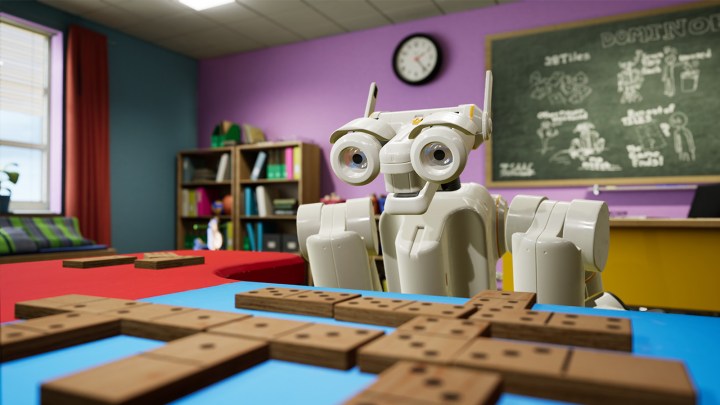
Training robots is far from easy. Programming every one of their tasks for every eventual outcome is a time consuming and relatively fruitless task for programmers, so more recently artificial intelligences (AI) and their real-world physical robotics, have been taught through machine learning.
The Isaac Lab Robot Simulator is the core technology that Nvidia is demoing at SIGGRAPH 2017 and it is using a little, humanoid robot named after the program to do it. He features treaded tracks for locomotion, twin-grip hands for manipulation, and a pair of camera-equipped eyes for tracking the real world. He even has a mouth and pseudo nose, which adds just enough humanity to steer clear of the uncanny valley.
Like other game-playing AI, Isaac is an expert at them and visitors to this year’s SIGGRAPH show can test his skills in a game of dominoes. But that is only one plane of existent that you can interact with Isaac in. Putting on a virtual reality headset, you will be able to step into the world as Isaac sees it and interact with a digital version of him in VR.
That virtual realm is Nvidia’s Holodeck technology — a collaborative, virtual workspace that allows designers and developers to work together to create something in a virtual environment. It supports photorealistic models too, so all participants can have a view of a product or object as it would be in the real world, without it ever existing there.
Isaac exists in both, though, and that is what Nvidia wants to promote at SIGGRAPH 2017 — its VR robot training system. It is designed to take the cost and risk out of training a robot using machine learning. Instead of making mistakes and potentially damaging the robotics or their environment, AI can explore and learn through trial and error in a virtual space that offers the same parameters as the real world.
That lack of risk is important for human interaction and makes it possible for AI to have near-infinite interactions with humans without the potential problems that could arise through those same interactions in the real world. Nvidia Isaac offers real-time rendering and developmental tools to aid creation in VR environments to train AI.
Nvidia is not the only one showing a blending of realities with digital entities at SIGGRAPH 2017 though. Disney introduced a “Magic Bench” which lets sitters interact with all sorts of animated characters.





